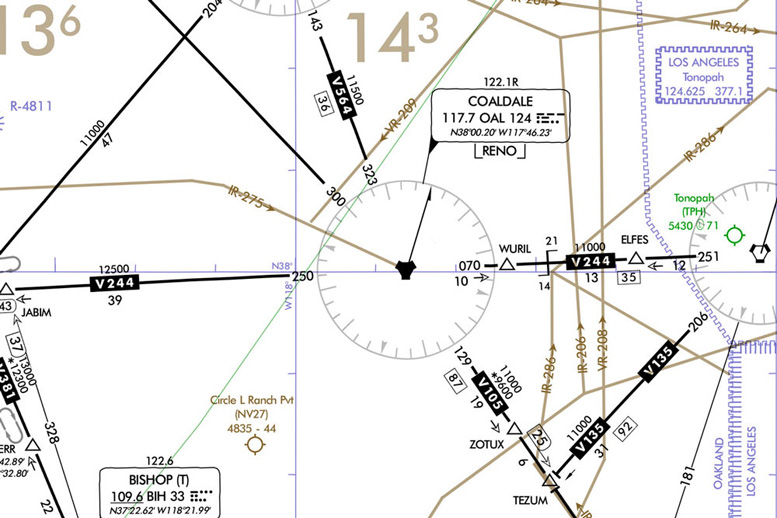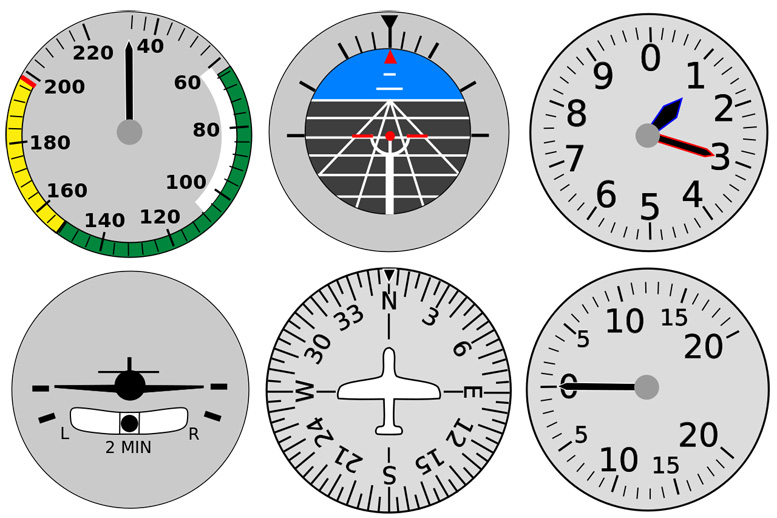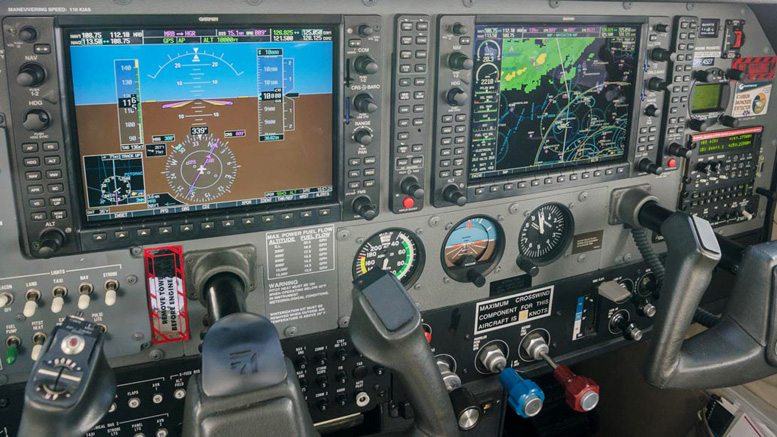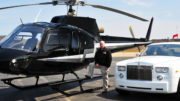IFR Aircraft Navigation

This “Old Pro” Argues That Flying The Gauges Is Not Play, And Offers Some Useful Labor-Saving Techniques
WHAT do you think about instrument flying?
If you’re strictly a VFR jock who stays out of the puffy white ones at all costs, you might not think about it at all.
But if you have any inclination towards IFR, you’d better think about it quite a bit. Instrument flying is not much more, or less, than a mental exercise.
It helps to be a good stick-and-rudder man, but it’s imperative that you have an active and accurate mind.
The first thing: you’ll want to think about is your limitations.
It’s a blow to the average birdman to suggest that he has limitations, but it’s a fact that has to be reckoned with. Confidence is absolutely necessary, but good judgment is just as important. Every pilot has a limit, and it’s the good pilot who can accurately determine his limit.
[FreshProduct productGroup=”ifr-glasses_1512024157″ showimage=”yes” showprice=”yes” showtitle=”yes” align=”right” buttonclass=”” buttontext=”Buy Now” newwindow=”_self”]
This limit depends on your experience, your knowledge and your physical condition. Take a look at yourself before every flight. Don’t tackle anything that is outside your limits; this is especially true of weather flying. Don’t confuse guts with stupidity.
The cheapest flying insurance you can carry is your knowledge. There are many good books on instrument flying and more good instrument pilots who will share their knowledge, some for fee and some for free. Whatever the cost — time or money — make an investment before you lose sight of the ground.
Every instrument course gives detailed information about the characteristics of the instruments. Don’t fall asleep at these sessions; they’re too important to miss. You must know what the instruments tell you, and what they don’t tell you. Look to these courses and manuals for technical details. There are a few important items every pilot should know.
The newer attitude-indicators are reliable; the biggest problem you’ll have with the attitude indicator is precession. The important thing is to be aware of this trait; the more your gauge precesses, the more aware you must be.
If you seem to drift off heading, check for precession. Once you recognize the problem, the correction is fairly easy.
The turn needle of the needle-and-ball has been used by many an old-timer to survive in the clouds.
It’s not as sophisticated as the newer instruments, but it has an extremely high degree of reliability. One caution, though. Don’t bank over about 15° if you’re flying IFR on the needle, because the needle pegs early and you can’t detect an increase in bank.
The situation can get raggedy if you’re not careful. Practice flying the needle without using the attitude indicator to alert you to its limitations. I’m sure it will convince you that you’ve got an ace in the hole.
One tricky thing you’ll note about the needle is its tendency to lean the wrong way when you roll into a turn. Wait until it settles down before you use it. In other words, don’t use the turn needle to roll into a turn. Practice with it, and get to know it.
Airspeed indicators (ASI) are simple to use and don’t fail very often. One thing to be prepared for is a frozen indicator. Those things freeze at the most inopportune times.
You can get along pretty well if you are familiar with power settings (or rpm settings) for the various phases of flight. Just set the power and fly the attitude; it helps if you’re lucky. Try it.
The altimeter (ALT) is a good performance instrument, but it’s only as good as the altimeter setting. Don’t mess up the setting! Tie a string around your finger. Do anything, but don’t forget! If you’re flying in the tens of thousands of feet, make sure you know which ten you’re at.
Experienced jocks have jumped out of good airplanes after a series of “low approaches” at 10,000 feet. If you make frequent errors when you read the altimeter, make a special effort to shake the habit. Habits like misreading the altimeter are short lived.
The most misused gauge of all is the vertical velocity indicator (VSI aka Vertical Speed Indicator). Set it to zero on the ground; no big thing, but it makes your work easier. If you want to make your work impossible, use the W indicator as a control instrument.
Here’s the tip of the day. If the W needle is moving, don’t look at it. It’s worthless until it stabilizes. You’ll chase it all over the sky if you don’t take heed.
If the needle has stabilized, it will give an instantaneous indication when you start getting off altitude. When it is moving, it has terrific lag. Do a couple of quick whifferdills some day (VFR) and you’ll see the needle pointed opposite the direction you’re going.
Even though you can do a poor job with the vertical velocity indicator and still be an adequate instrument pilot, you’ll not master the gauges unless you use it correctly.
There’s a lot more that should be said about the instrument characteristics, but it’s not within the scope . . . Let’s get on to some techniques that might be helpful.
A cardinal rule of IFR flying is, “Believe the instruments.” Don’t ever think that you can fly in the soup by the seat of your pants.
There’s no way. Spatial disorientation, vertigo, can just about drive you nuts; and nobody is immune. When a bad case sets in, grin and bear it. You can help avoid vertigo by flying smoothly.
As a matter of fact, being smooth and positive on the controls will avoid a multitude of sins.
One of the weaknesses of many pilots is their inability, or refusal, to distinguish between control instruments and performance instruments.
The distinction is not just for academic purposes; it gives a clue to good instrument techniques. The attitude indicator and the rpm gauge (or whatever is used to set the power) are the control instruments.
They are the instruments that can and should be used to control the airplane. The performance instruments are all the others, and their function is to tell you how your control settings are working.
That’s the only way the performance instruments should be used. There’s a strong temptation to look at a performance instrument, like the airspeed indicator, and jockey the throttle until the airspeed is right.
If the airplane responds instantaneously to power changes, you will get on airspeed, but it is still bad technique. You’ll do a better job of flying instruments if you control the air craft with control instruments and monitor performance with the performance instruments.
It will save work in the long run, because you won’t be as apt to chase the needles. This approach to instrument flying gives a clue to cross checking the instruments.

The most common criticism of a fledgling instrument pilot is “slow cross check,” which usually means that the student fails to look at each of the performance instruments often enough.
Actually any deficiency in your clock work could be attributed to a slow or a bad cross check, assuming, of course, that you handle the machine well enough to make corrections, if you could only keep up with the corrections that need to be made.
What can you do to help your cross check? Ultimately, with experience and good techniques, you should be able to look at the panel and see several instruments simultaneously.
One of those good techniques that keeps cropping up is, “Before you look at an instrument, know what you want to see.” It’s a waste of time to look at an instrument and begin reading it like a 10 cent novel.
A lot of pilots think that a speedy cross check consists of focusing your eyes on every instrument in the cockpit once every 10 seconds. If you don’t get useful info from an instrument when you look at it, you’ve wasted your time. It’ll be far better to get one useful look every 30 seconds than three useless ones.
If you look at a gauge without planning ahead, you’ll first have to identify the gauge. Then you’ll read the needle (or bar, or whatever). Next you’ll compare that to what you want it to read. Then you’ll measure the amount and direction of the correction you need.
Time. How long did it take? However long it was, you can do better. Here’s how. If you want to check the airspeed, discipline yourself to planning your look. Before you glance over, decide what airspeed you want to have.
Consider not only what the speed should be, but where the needle should be to indicate this airspeed. You have a precise picture that you want to see when you look at the airspeed indicator.
Now look. If the picture is not as expected, you instantly know whether the needle is low or high, and it only takes a fraction more time to see exactly how much error you have. You get the same information in much less time, and you have your mind in gear to boot.
What is the difference between VFR and IFR flying?
VFR stands for visual flight rules, and the term refers to a set of rules created by the FAA for flight in VMC, or visual meteorological conditions. These are terms that even pilots sometimes use incorrectly.
IFR stands for instrument flight rules – the set of rules that govern aircraft that fly in IMC, or instrument meteorological conditions. In general terms, instrument flying means flying in the clouds. … Flying in the clouds (IMC) requires an IFR flight plan and an instrument rating.
The speed with which you check I all the instruments depends on how efficient your mind is, which depends on your knowledge of the instruments, your experience and your currency.
Don’t think that you can leap into the cockpit after a layoff and immediately get your cross check in gear. You have to consider your currency before you tackle a weather problem.
Wait a second! There seems to be a loophole in that cross check technique. What are you doing while you plan what you want to see on the airspeed indicator? You haven’t saved any time if you’re looking off into space. That’s right.
But what you’re doing is looking at the control instruments and keeping the airplane pointed and powered properly. Therefore you must also have a mental picture of the attitude indicator and the rpm gauge that you are trying to hold.
These instruments deserve most of your time, especially the attitude indicator. It takes the place of looking outside in VFR conditions, and you certainly want to do a lot of that. Your cross check, then, should be centered around the attitude indicator.
Fly the attitude indicator and, as frequently as your mind will allow, take useful planned glances at all of the performance instruments.
If you find a deviation, what should you do? If the deviation is on the attitude indicator or on the rpm gauge, correct it; those are control instruments.
If it is on any other instruments, think about it. That sounds like a waste of time, but it’s quite the opposite. You can’t always look at one gauge and determine what correction should be made. Correlate the instruments.
If you don’t you’ll multiply your work and you’ll multiply your errors. For instance, if your airspeed is high, don’t immediately honk back on the power and proceed to congratulate yourself for being positive on the controls.
“Its important to also state that VFR are used mainly by Helicopters or aircraft that do not go far into the skies/cloud. While IFR are used mainly by aircraft that flies high into the cloud especially on Long distance travel.” – Victor Oyejide
Look at your vertical velocity and your altimeter. If they are as desired, you do have to much power; you should look at your rpm gauge and throttle back some precise amount.
However, if you see that you are low on altitude and descending, you might even need more power to get back to level flight at the right airspeed and altitude. Then again, maybe all you need is to raise your nose a bar width and then drop it back to the level flight picture when you get back on altitude.
If you fail to correlate the instruments you might turn a simple pitch change into a series of pitch and power changes that lasts until you reach the chocks or fly into the ground, whichever comes first. You’ll never have to make any hasty changes in pitch or power in IFR conditions unless you let the machine get away from you.
Keep your mind busy with your cross check to help you correlate the instruments and you will probably stay out of trouble.
Another way to avoid untenable situations when you’re instrument flying is to make small corrections.
Over-correcting is habit forming; don’t start it. If you’re in a vertical dive, you obviously need a fairly large pitch correction, but you don’t get into a vertical dive without either falling asleep or over-correcting to begin with.
The tendency to over-correct comes from either a lack of confidence, a lack of experience, a lack of knowledge, or just plain fear. Most pilots won’t agree to any of them except perhaps a lack of experience.
You’ll gain the experience much more rapidly if you will use the control instruments properly. You can soon learn how much pitch change will give you a comfortable, steady climb, if you will enter each climb by making a precise pre-selected pitch change on the attitude indicator.
[FreshProduct productGroup=”hcifr-app_1512024069″ showimage=”yes” showprice=”yes” showtitle=”yes” align=”right” buttonclass=”” buttontext=”Buy Now” newwindow=”_self”]
Once you’ve gained this experience, you’ll be able to spend more time planning your approach at your destination and less time staying on altitude. Make those corrections positive, but small. What is small?
This all depends on the airplane you’re flying and the situation you’re in, but as a general rule, take the correction you’d like to make and halve it. Since most pilots are tigers in the sky, that works fairly well.
Speaking of tigers, be sure to put instrument flying in a proper frame of reference. While there might be some daredevils who relish IFR aerobatics, that’s contrary to good judgment. The object of IFR flying is generally conceded to be getting out safely on the other side.
Save your super stunt — whether it’s a double Immelmann or a 35-degree bank level turn — for VFR. The challenge in IFR is to be as slick and smooth as glass and as safe as you are smooth.
You can get into enough trouble fighting the elements without throwing more into the pot.
One thing you do want to watch very closely is your transition from VFR to IFR or from IFR to VFR.
You can make a big blunder if you don’t. When you’re about to go IFR, start your cross check well before you enter the weather, so you will be adjusted to the gauges and can continue with no big traumatic experience when the ground disappears.
The key play is to get ahead of the aircraft and stay there. It’s harder to catch up when it’s just you and the clocks. It’s just as important to continue your cross check for a while after you’ve broken out.
For one thing you will usually not make a clean break, but will pop in and out of wisps until you’re finally in the open. If you abandon the gauges at the first sight of land, you’ll be unprepared if one of those wisps was underestimated.
Another thing, if you are too hasty to get away from the instruments, you’re apt to be too slow looking back at them to even maintain safe VFR flight. This is especially true if you break out on an approach with the field in sight.
You can fall behind the airplane in a big hurry. Keep this in mind. There’s a lot that could be said about using specific instruments, but most of that can be found in instrument manuals.

It’s important enough for you to seek it in general terms, use all the performance instruments to tell you what you want to do and then do it with the control instruments. Recognize the limitations of each of the instruments and, most important of all, recognize your own limitations.
You don’t have to talk about them with the other pilots, but be aware of your capabilities every time you take off. It takes a lot of practice to be an expert instrument pilot; it takes good sense to be any kind of an instrument pilot for very long.
Instrument flying is serious business and it calls for an alert, active mind. If you’re just flying for fun and don’t feel like working very hard, don’t file IFR or it’ll wreck all your plans.
(The author, a former Air Force pilot, spent six and one-half years flying T-3A, T-37, T-33 and F-100 aircraft. He flew the Super Sabres in France, Italy, Thailand and Japan as well as the U.S., and closed his career as an instrument instructor pilot in the big Century Series fighter at Luke AFB, Arizona.)
We recommend: http://www.ifr-magazine.com/




Be the first to comment on "IFR: The Name Of The Game Is WORK!"